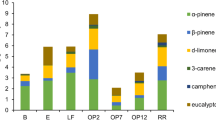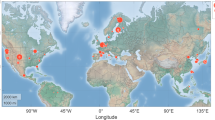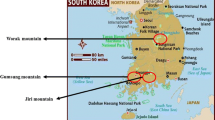Abstract
Laboratory experiments under controlled environmental conditions are a useful tool to investigate the influence of different environmental parameters on VOC emissions from plants individually. Before using the obtained results to interpret measurements under ambient conditions, it has to be ensured that the laboratory system is suitable for performing emission rate measurements under ambient-like conditions to derive algorithms describing the emissions of volatile organic compounds as a function of physical variables like temperature and light intensity. Here we compare results from monoterpene emission rate measurements with Scots pines (Pinus sylvestris L.) under both ambient environmental conditions using a mobile plant enclosure chamber, and under controlled laboratory conditions in a continuously stirred tank reactor. The different analytical instruments to quantify monoterpene emissions were compared in an intercalibration experiment. Measurements of the mixing ratios of α -pinene, β -pinene, 3-carene, camphene, and limonene on the order of some hundred parts per trillion differed by less than 20%. The laboratory system has proven capable of providing ambient-like conditions and results of monoterpene emission rate measurements under laboratory conditions could be extrapolated to the natural environment. Monoterpene emission rate measurements with identical specimens of Scots pines conducted within small temporal differences under similar laboratory and outdoor conditions agreed well. Both laboratory and outdoor experiments clearly showed that distinct and constant values neither exist for the standard emission rates nor for the emission pattern of monoterpenes from Scots pine. Temporal variations in the standard emission rates from identical specimens and plant-to-plant variations were on the order of one magnitude.
Similar content being viewed by others
References
Chameides, W. L., Lindsay, R. W., Richardson, J., and Kiang, C. S., 1988: The role of biogenic hydrocarbons in urban photochemical smog: Atlanta as a case study, Science 241, 1473–1475.
Fehsenfeld, F., Calvert, J., Fall, R., Goldan, P., Guenther, A. B., Hewitt, C. N., Lamb, B., Liu, S., Trainer, M., Westberg, H., and Zimmerman, P., 1992: Emissions of volatile organic compounds from vegetation and the implications for atmospheric chemistry, Global Biogeochem. Cycles 6(4), 389–430.
Guenther, A. B., Zimmerman, P., Harley, P. C., Monson, R. K., and Fall, R., 1993: Isoprene and monoterpene emission rate variability: Model evaluations and sensitivity analysis, J. Geophys. Res. 98, 12,609–10,617.
Guenther, A. B., Hewitt, C. N., Erickson, D., Fall, R., Geron, C., Graedel, T., Harley, P., Klinger, L., Lerdau, M., McKay, W. A., Pierce, T., Scholes, B., Steinbrecher, R., Tallamraju, R., Taylor, L., and Zimmerman, P., 1995: A global model of natural volatile organic compound emissions, J. Geophys. Res. 100, 8873–8892.
Juuti, S., Arey, J., and Atkinson, R., 1990: Monoterpene emission rate measurements from a monterey pine, J. Geophys. Res. 95, 7515–7519.
Komenda, M., Parusel, E., Wedel, A., and Koppmann, R., 2001: Measurements of biogenic VOC emissions: Sampling, analysis and calibration, Atmos. Environ. 35, 2069–2080.
Komenda, M. and Koppmann, R., 2002: Monoterpene emissions from Scots pine (Pinus sylvestris): Field studies of emission rate variabilities, J. Geophys. Res. 107, 10.1029/2001JD000691.
Lamb, B., Westberg, H., Allwine, G., Quarles, T., 1985: Biogenic hydrocarbon emissions from deciduous and coniferous trees in the United States, J. Geophys. Res. 90, 2380–2390.
Priemé, A., Knudsen, T. B., Glasius, M., and Christensen, S., 2000: Herbivory by the weevil, Strophosoma melanogrammum, causes severalfold increase in emission of monoterpenes from young Norway spruce (Picea abies), Atmos. Environ. 34, 711–718.
Schade, G. W., Goldstein, A. H., and Lamanna, M. S., 1999: Are monoterpene emissions influenced by humidity?, Geophys. Res. Letts. 26, 2187–2190.
Schuh, G., Heiden, A. C., Hoffmann, T., Kahl, J., Rockel, P., Rudolph, J., and Wildt, J., 1997: Emissions of volatile organic compounds from sunflower and beech: Dependence on temperature and light intensity, J. Atmos. Chem. 27(3), 297–318.
Shao, M., Czapiewski, K. v., Heiden, A., Kobel, K., Komenda, M., Koppmann, R., and Wildt, J., 2001: VOC emissions from Scots pine: Dependence on temperature, light intensity, and season, J. Geophys. Res. 106, 20,483–20,492.
Staudt, M., Bertin, N., Hansen, U., Seufert, G., Ciccioli, P., Foster, P., Frenzel, B., and Fugit, J.-L., 1997: Seasonal and diurnal patterns of monoterpene emissions from Pinus pinea (L.) under field conditions, Atmos. Environ. 31(SI), 145–156.
Staudt, M., Bertin, N., Frenzel, B., and Seufert, G., 2000: Seasonal variation in amount and composition of monoterpenes emitted by young Pinus pinea trees – implications for emission modeling, J. Atmos. Chem. 35, 77–99.
Tingey, D. T., Manning, M., Grothaus, L. C., Burns, W. F., 1980: Influence of light and temperature on monoterpene emission rates from Slash Pine, Plant Physiol. 65, 797–801.
Tingey, D. T., Turner, D. P., and Weber, J. A., 1991: Factors controlling the emissions of monoterpenes and other volatile organic compounds, in T. Sharkey et al. (eds), Trace Gas Emissions by Plants, Academic Press, San Diego, pp. 93–119.
Trainer, M., Williams, E. J., Parrish, D. D., Buhr, M. P., Allwine, E. J., Westberg, H. H., Fehsenfeld, F. C., and Liu, S. C., 1987: Models and observations of the impact of natural hydrocarbons on the rural ozone, Nature 329, 705–707.
Turlings, T. and Tumlinson, J., 1992: Systemic release of chemical signals by herbivore-injured corn, Proceedings of the National Academy of Science U.S.A. 89, 8399–8402.
Wildt, A., Kley, D., Rockel, A., Rockel, P., and Segschneider, H. J., 1997: Emission of NO from higher plant species, J. Geophys. Res. 102(D5), 5919–5927.
Yatagai, M., Ohira, M., Ohira, T., and Nagai, S., 1995: Seasonal variations of terpene emission from trees and influence of temperature, light and contact stimulation on terpene emission, Chemosphere 30, 1137–1149.
Author information
Authors and Affiliations
Rights and permissions
About this article
Cite this article
Komenda, M., Kobel, K., Koppmann, R. et al. Comparability of Biogenic VOC Emission Rate Measurements under Laboratory and Ambient Conditions at the Example of Monoterpene Emissions from Scots Pine (Pinus sylvestris). Journal of Atmospheric Chemistry 45, 1–23 (2003). https://doi.org/10.1023/A:1024082410326
Issue Date:
DOI: https://doi.org/10.1023/A:1024082410326




